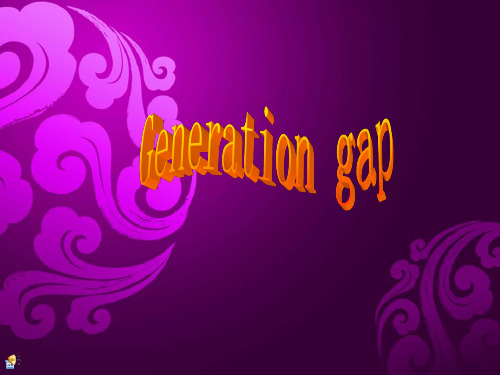generation gap(代沟)英文 PPT
- 格式:ppt
- 大小:1.33 MB
- 文档页数:11





•In 1960s,American anthropologistMargaret Mead first put forward thisword.(上世纪60年代,美国人类学家玛格丽特.米德首先提出了“代沟”这个概念。
)•The two generation have different values ,the ways of thinking ,behavior and ethical standards .Those result in difference of ideas and Behaviorhabits between them.(代沟是指两代人因价值观念、思维方式、行为方式、道德标准等方面的不同而带来的思想观念、行为习惯的差异。
)In modern times,science and technology hav brought many convenient to us.Many older people don't use that our new generation have the honor to use.(在当今时代,科技给我们带来了许多便利,许多老一辈的人没用过的东西我们新一代却有幸用用上了。
)Two generation of growth is different,have different experiences,the outlook on life,world, values are also different.(两代人有不同的成长经历,产生的人生观,价值观,世界观也就不同了。
)A simple example is:when an elderly ormiddle-aged people say someone is "honest", that is praise him;but when a 80s or 90s saythat ,you probably not happy,because it represents stiff,rigid.(举一个简单的例子:当一个老年人或中年人说某人“老实时”,那是在夸奖他;而当一个80后或90后这样说是,你可能就不高兴了,因为那或许意味着死板,木讷。

generation gap课件Generation GapIntroductionThe generation gap is a phenomenon that has been observed throughout history. It refers to the differences in attitudes, beliefs, and values between different generations. This gap is often characterized by a lack of understanding and communication between older and younger generations. In this article, we will explore the causes of the generation gap and its impact on society. Causes of the Generation Gap1. Technological advancementsOne of the main causes of the generation gap is the rapid advancement of technology. Older generations often struggle to keep up with the latest gadgets and digital platforms, while younger generations embrace them effortlessly. This technological divide leads to differences in communication styles and interests, making it challenging for older and younger individuals to connect with each other.2. Changing social valuesSociety is constantly evolving, and with it, social values change. Each generation grows up in a different social context, which shapes their beliefs and attitudes. For example, older generations may hold traditional values and conservative views, while younger generations tend to be more progressive and open-minded. These differing values can create conflicts and misunderstandingsbetween generations.3. Education and upbringingEducation plays a crucial role in shaping individuals' perspectives and values. Each generation receives a different education and upbringing, which can contribute to the generation gap. Older generations may have been raised in a more authoritarian and disciplined manner, while younger generations are often encouraged to express themselves and think independently. These different educational approaches can lead to clashes in opinions and expectations. Impact of the Generation Gap1. Communication breakdownThe generation gap often leads to a breakdown in communication between older and younger individuals. Differences in language, interests, and cultural references can make it difficult for generations to understand each other. This lack of understanding can result in conflicts and strained relationships within families, schools, and workplaces.2. Cultural preservationWhile the generation gap can create conflicts, it also allows for the preservation and evolution of culture. Older generations carry the traditions and wisdom of the past, while younger generations bring fresh perspectives and innovative ideas. By bridging the generation gap, society can benefit from the exchange of knowledge and experiences, ensuring the continuity of cultural heritage.3. Social changeThe generation gap is often a catalyst for social change. Younger generations challenge established norms and push for progress and equality. Their unique perspectives and demands can lead to societal advancements, such as changes in policies, attitudes towards social issues, and technological innovations. The generation gap, therefore, can be seen as a driving force for positive societal transformation.Bridging the Generation Gap1. Open-mindedness and empathyTo bridge the generation gap, both older and younger individuals must practice open-mindedness and empathy. It is essential to listen to each other's perspectives and try to understand the reasons behind differing opinions. By fostering empathy, generations can find common ground and build stronger relationships based on mutual respect.2. Communication and dialogueEffective communication is key to bridging the generation gap. Both older and younger individuals should make an effort to communicate openly and honestly. This includes actively listening to each other, asking questions, and engaging in meaningful conversations. By fostering dialogue, generations can bridge the gap and find shared values and interests.3. Mutual learning and respectEach generation has unique knowledge and experiences to offer. By embracing mutual learning and respect, older and younger individuals can benefit fromeach other's wisdom and perspectives. Older generations can share their life experiences and traditional values, while younger generations can provide fresh insights and technological expertise. This exchange of knowledge fosters understanding and appreciation between generations.ConclusionThe generation gap is a complex phenomenon that arises from various factors such as technological advancements, changing social values, and different education approaches. While it can lead to communication breakdowns and conflicts, it also offers opportunities for cultural preservation and social change. By practicing open-mindedness, empathy, effective communication, and mutual learning, generations can bridge the gap and create a harmonious and progressive society.。